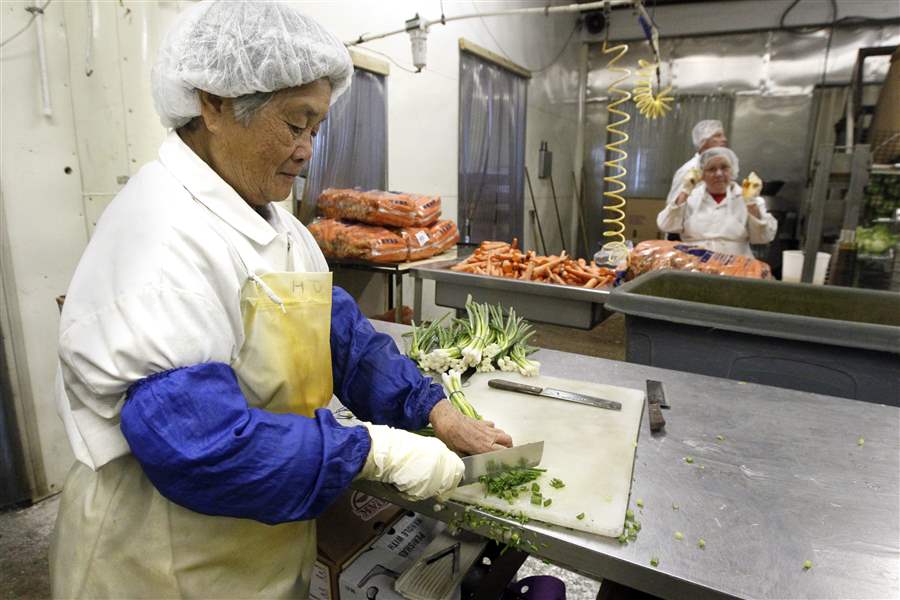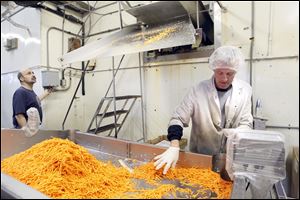
Sylvania students to see more fruit, vegetables
Nutritional requirements aid produce vendors, processors
7/29/2013
Juan Huang chops onions at Chariott Food. Sylvania schools are increasing their use of fresh fruits and vegetables, which is good for the bottom line of produce vendors such as Chariott in Toledo.
The Blade/Amy E. Voigt
Buy This Image

Juan Huang chops onions at Chariott Food. Sylvania schools are increasing their use of fresh fruits and vegetables, which is good for the bottom line of produce vendors such as Chariott in Toledo.
In his second year as director of purchasing and food service for Sylvania City Schools, Joseph Shamy is aiming to strike a balance between taste, nutrition, and budget.
A math teacher at Highland Elementary School before stepping into the food management position in September, 2012, Mr. Shamy had been employed in area restaurants for more than 20 years.
With a passion for food and satisfying customers, he is determined to change the district’s menu, employ a service-friendly staff, and offer products from local businesses.
In January, he added fresh fruit and vegetables to the daily menu.
He responded to a student survey that called for more fresh salad by adding a chef or garden salad, and a turkey wrap to the daily menu.
That increase in vegetables is good for Chariott Foods Inc.
Mike Okdie, who owns the Toledo wholesale produce and processing business with his wife, Shirley, said he expects his weekly food deliveries to the school, that weighed in at about 1,000 pounds this year, to triple in the new school year.
Mr. Okdie started supplying the school with sliced onions, carrots, and cabbage, diced green peppers, broccoli florets, whole watermelon, bananas that are just the right size for kids, and more since September, 2012.
Food is cleaned, skinned, cut, and vacuumed sealed on Sunday.
By 9:30 Monday morning the foods are delivered to the school.
Now, that delivery will include a salad greens mix too.
“My role is to make a balance between nutritious and tasty,” Mr. Shamy said.
The high school students, who asked for “a more flavorful and ethnic menu” will be able to choose from items such as sweet and sour chicken with broccoli, godfather meatball sub, a walking taco, and rotini pasta bake.

Warren Hawkins, right, bags carrots while Mike Okdie, owner of Chariott Foods, operates the shredder.
The walking taco is made with low-fat, reduced-sodium Doritos. Mr. Shamy acknowledged that it’s not the healthiest snack, but says “we took everything from these kids.” Since Ohio Senate Bill 210 was enacted in June, 2010, cookies, soda, and chips have been eliminated from schools.
“Instead of making all this change, let’s make a compromise,” he said.
When seeking out a bid from Barry Bagels for a product that fit the school’s nutritional guidelines, the company and the school district struck a compromise.
Father and son Barry and Mark Greenblatt, owners of the restaurant chain founded in Sylvania in 1972, adjusted the size of their bagel to win the school bid.
“He reached out to us and said we would love for you to come back, and we asked ‘what do you need us to do,’” Mark Greenblatt said. The company had not been the school’s bagel vendor for about a year.
In August, 2012, a two-ounce whole wheat bagel appeared on the menu.
This year, because the U.S. Department of Agriculture has suspended limits on meats and breads, the bagel is now three ounces, an ounce less than the store product.
New items on the menu from local businesses include hummus from The Beirut restaurant, and Sautter’s Food Center’s sliced deli turkey.
In order to provide more fresh options and grow the list of local vendors, parent support is essential, Mr. Shamy said.
The department operates as a separate entity with a $1.5 million budget for 2013 that is drawn from lunch sales.
For each lunch served, the school got 27 cents of government reimbursement last year. The school lunch participation rate is 2,500 of 8,000 students.
If the same credit rate were applied this year, with elementary lunches costing $2.50 and $2.70 at the high school, and participation increased by 500, he said the food program would gain $135 a day, and $24,300 a year in state credits.
That money could go towards purchasing better food, he said.
Wendy Ludwig, who never buys school lunches for her three children because she finds them “unappealing,” said her children would purchase the salad and turkey wrap lunches.
However, she took issue with chicken patties, corn dogs, and walking tacos.
“I would pay $4 a lunch for better food,” she said.
Contact Natalie Trusso Cafarello at: 419-206-0356 or ntrusso@theblade.com.